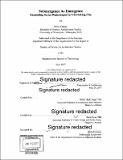| dc.contributor.advisor | Rafael (Rafi) Segal and Brent Ryan. | en_US |
| dc.contributor.author | Outlaw, Milan (Milan Jean-Marie) | en_US |
| dc.contributor.other | Massachusetts Institute of Technology. Department of Architecture. | en_US |
| dc.coverage.spatial | n-us-wi | en_US |
| dc.date.accessioned | 2017-09-15T15:36:44Z | |
| dc.date.available | 2017-09-15T15:36:44Z | |
| dc.date.copyright | 2017 | en_US |
| dc.date.issued | 2017 | en_US |
| dc.identifier.uri | http://hdl.handle.net/1721.1/111496 | |
| dc.description | Thesis: S.M. in Architecture Studies, Massachusetts Institute of Technology, Department of Architecture, 2017. | en_US |
| dc.description | Cataloged from PDF version of thesis. | en_US |
| dc.description | Includes bibliographical references (page 143). | en_US |
| dc.description.abstract | This thesis seeks to reclaim spaces of urban disinvestment by developing alternative forms of contact and connectivity across urban water systems. Framing water as a mode of gathering, this project connects myriad urban realities, peoples, and practices. Alternative forms of linkages provide users an opportunity to disrupt systems of power and inequities that have worked to uphold decades of urban injustice, class isolation, and racial segregation. This is most necessary in socially marginalized spaces, where social cohesion is often fractured or nonexistent. Such is the case in Milwaukee, Wisconsin, a once flourishing industrial city founded at the confluence of three rivers on the shores of Lake Michigan. The city's water network was once vital to the growth and livelihood of the city, as a port, a live blood of its vibrant industries, and for transportation and recreation. The city's seemingly public water network today is hyper-policed and inaccessible to a large demographic, due to the city's history of segregation. In the last decades of the 20th century, as industries vanished, the city was left waning - its remaining businesses and amenities rapidly declined and urban decay spread, creating inequality, unemployment, and segregation. Those hit hardest were people of color - African Americans and Latinos, often unable to escape the unimaginable systemic conditions. Acknowledging the existence of these communities and spaces, this thesis asks: How can design respond to inequalities created by urban systems and how might water be used a means of democratization? Visualizing new terrains of navigating and reimagining the city, this design proposes to submerge fallows and voids within the city and create a canal network in their place. In doing so, this work offers new ways of imagining river recreation and links leftover areas via a third space - the network of water passages. Creating socially relevant third spaces allows for unstructured interaction and engagement across social and cultural differences, socially binding marginalized spaces and peoples. | en_US |
| dc.description.statementofresponsibility | by Milan Outlaw. | en_US |
| dc.format.extent | 146 pages | en_US |
| dc.language.iso | eng | en_US |
| dc.publisher | Massachusetts Institute of Technology | en_US |
| dc.rights | MIT theses are protected by copyright. They may be viewed, downloaded, or printed from this source but further reproduction or distribution in any format is prohibited without written permission. | en_US |
| dc.rights.uri | http://dspace.mit.edu/handle/1721.1/7582 | en_US |
| dc.subject | Architecture. | en_US |
| dc.title | Submergence as emergence : expanding social waterscapes in a shrinking city | en_US |
| dc.title.alternative | Expanding social waterscapes in a shrinking city | en_US |
| dc.type | Thesis | en_US |
| dc.description.degree | S.M. in Architecture Studies | en_US |
| dc.contributor.department | Massachusetts Institute of Technology. Department of Architecture | |
| dc.identifier.oclc | 1003322695 | en_US |
